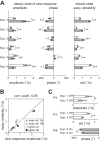Sensory reweighting dynamics following removal and addition of visual and proprioceptive cues
- PMID: 27075544
- PMCID: PMC4969387
- DOI: 10.1152/jn.01145.2015
Sensory reweighting dynamics following removal and addition of visual and proprioceptive cues
Abstract
Removing or adding sensory cues from one sensory system during standing balance causes a change in the contribution of the remaining sensory systems, a process referred to as sensory reweighting. While reweighting changes have been described in many studies under steady-state conditions, less is known about the temporal dynamics of reweighting following sudden transitions to different sensory conditions. The present study changed sensory conditions by periodically adding or removing visual (lights On/Off) or proprioceptive cues (surface sway referencing On/Off) in 12 young, healthy subjects. Evidence for changes in sensory contributions to balance was obtained by measuring the time course of medial-lateral sway responses to a constant-amplitude 0.56-Hz sinusoidal stimulus, applied as support surface tilt (proprioceptive contribution), as visual scene tilt (visual contribution), or as binaural galvanic vestibular stimulation (vestibular contribution), and by analyzing the time course of sway variability. Sine responses and variability of body sway velocity showed significant changes following transitions and were highly correlated under steady-state conditions. A dependence of steady-state responses on upcoming transitions was observed, suggesting that knowledge of impending changes can influence sensory weighting. Dynamic changes in sway in the period immediately following sensory transitions were very inhomogeneous across sway measures and in different experimental tests. In contrast to steady-state results, sway response and variability measures were not correlated with one another in the dynamic transition period. Several factors influence sway responses following addition or removal of sensory cues, partly instigated by but also obscuring the effects of reweighting dynamics.
Keywords: balance; humans; posture control; sensory integration; sensory reweighting.
Copyright © 2016 the American Physiological Society.
Figures





References
Publication types
MeSH terms
LinkOut - more resources
Full Text Sources
Other Literature Sources
Medical

